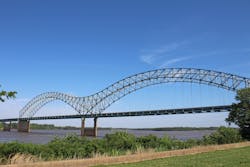No Strings Attached
By Mehdi Kalantari Khandani, Contributing Author
The Hernando de Soto Bridge carries Interstate 40 over the Mississippi river in west Memphis and Arkansas. It is a two-span continuous tied-arch bridge with 900-foot spans, and about 100 feet above the water.
The Hernando de Soto Bridge is of particular significance in the country’s transportation system because of its location. The bridge is crucial to the business community in greater Memphis, as about 60,000 vehicles pass over and more than 200 barges move under the bridge per day. It also has a critical role as a major evacuation route, which is frequently used by emergency vehicles.
Memphis is known to be the capital of logistics in the United States and is one of the most important logistical hubs in the world. This city has heavily invested in logistical services relating to the transportation, sorting, dispatch, and distribution of goods for national and international transit. The city is the host to multiple great courier and transportation companies, including the FedEx headquarters, which receives more than 100 bulk-loaded trailers and almost 80 containerized transport vehicles (CTVs) per day. As a result, the Hernando de Soto Bridge is one of the most significant transportation resources that connects Memphis to Arkansas and acts as a gateway to most western states.
Fracture Discovery
The Hernando de Soto Bridge construction was started in 1967, and the bridge was inaugurated on August 17, 1973. In the U.S., many steel bridges built between 1940 and 1980 suffer from a lack of redundancy in design. During the beginning of this era, raw materials for bridge construction experienced significant shortages (due to World War II and other factors), and many of the redundancies of more recent bridge designs were considered a luxury. Most of the steel bridges built in those years are still in service, and as they continue to age, they are carrying an ever-increasing volume of traffic with each passing year.
While performing routine inspections on May 11, 2021, a partial fracture was discovered in a tie girder that supports one of two tied-arch truss spans. The fracture was reported at a welded plate transition in the upstream, box-shaped tension tie member (A box-shaped tie girder acts as a tension strut to restrain the outward thrust forces of the arches at the piers). As a result of the crack, the bridge inspectors called 911 to request an immediate shutdown of the six-lane bridge, which remained closed to traffic until completion of emergency repairs in August 2021.
Economic Impacts Due to Bridge Closure
The immediate shut-down forced traffic to be rerouted, and there was a massive effort to ease the resulting congestion of both vehicles and barges. Because bridges frequently become a bottleneck as vehicles funnel over limited lanes, a bridge failure affects local traffic and can have negative economic impact as well. The bridge was closed for about three months. In addition, the detours were circuitous, causing congestion and heavy traffic in the area. According to multiple reports and studies, the cost of closure of the bridge was estimated to be $2-3 million per day.
Instrumentation Efforts
During emergency repairs of the bridge, tension needed to be applied to the fractured members to ensure correct installation of retrofits. Such an operation involves two main risks. First, equipment needed to complete such an operation (such as cranes or hydraulic machinery) are heavy and moving them on the bridge with fractured load bearing members involves a significant risk. Second, there is a risk that the tension applied to the fractured members produce undesired excessive strain in other members producing further damage to the bridge.
Monitoring and instrumentation had to be done quickly due to the high urgency of repairs and before conducting repairs on the tie girder. Thus, authorities needed a very quick-to-deploy system to monitor critical members of the bridge. In addition, the system was required to provide reliable, precise, and real-time data on all high-risk members.
A wireless strain sensor provided a perfect solution to meet the monitoring needs of the project. With an adhesive mount, it was fast to install the monitoring system. After installation, the connected wireless strain gauge delivered a live stream of readings on the strain and stress in the monitored members.
In a matter of days, roughly 44 wireless gauges were installed on the bridge to all high-risk members to monitor loads (tension and compression) during the repair process, which involved applying tension to the fractured member. In addition, the other benefit of the strain gauges was that they monitored stress in the critical members when heavier equipment, such as cranes, were moved on the bridge to carry special equipment and retrofit plates.
The readings helped to inform the immediate decision-making process to ensure all operations were safe. The data aided the bridge repair engineers in gathering information around real time strain. Furthermore, after the bridge was completed in 2021, the wireless sensors continued to monitor the structure to ensure the repairs were performing as expected.
Overall, the use of wireless strain gauge sensors proved to be a successful practice in this project. They minimized the downtime of the Hernando de Soto Bridge, and they can help to identify recurrence of the issue by detecting change to the pattern of strain as a result of thermal effects or live loads.
Mehdi Kalantari Khandani, PhD, is the President and CTO of Resensys.
